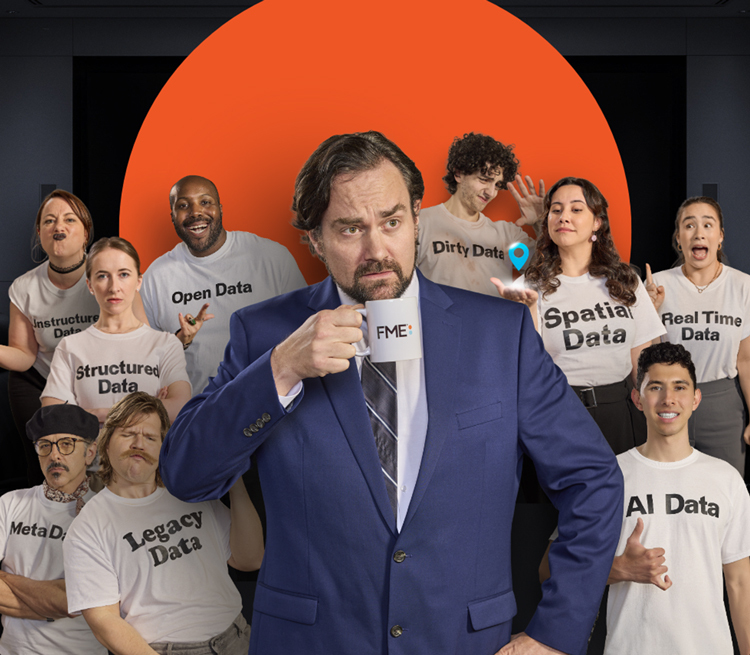AI Agent Use Cases
AI agents are intelligent systems designed to act autonomously to achieve specific goals by perceiving the environment in which they are deployed. They are rapidly transforming industries by revolutionizing customer experience, employee experience, data processing, and even creative work.
With the advent of no-code agentic platforms, building AI agents is now as easy as a few drag-and-drop operations. This article explores key use cases of AI agents and explains the basics of implementing them with agentic frameworks.
Summary of key AI agent concepts
| Concept | Description |
|---|---|
| Understanding AI agents | AI agents are intelligent systems that can make autonomous decisions to achieve specific goals. |
| Improving customer experience | Conversational AI, automated customer onboarding, and automated response systems are agentic AI features that improve customer experience. |
| Improving employee productivity | Agentic solutions can improve employee efficiency by aiding in decision-making and process automation. They can be used to implement agentic workflows and decision-making agents that help employees in their daily work, such as root cause analysis and resource optimization. |
| Data agents | Data transformation and Personal identifiable information detection benefit from AI agents that can use context and metadata to make changes to data. They can be used to implement schema drift detection, automated data mapping, error correction, and security policy enforcement. |
| Creative agents | AI agents can help in creative fields like programming and UI design with a bit of support from human stakeholders. |
Understanding AI agents
An AI agent is a goal-driven system that can act autonomously and navigate the environment to achieve its final goal. These agents are different from yesteryear’s robotic process automation (RPA) systems in the sense that they don’t require predefined logic and require only the final goal or intent as input. They are intelligent enough to plan the sequence of actions required to achieve the goal and act accordingly.
In a nutshell, an AI agent has the following core capabilities
- Language models provide autonomous decision-making capability for agents. They allow agents to perceive, reason, and plan actions.
- Memory is provided by databases, cache implementations, and context fed along with the prompt. Databases provide long-term knowledge and historical data, while cache implementation and prompt context provide short-term memory.
- Functions and tools allow agents to execute actions. In other words, they connect agents to the outside or external world through API calls. They can be APIs that fetch data, APIs that trigger physical actions, or interfaces for generating text, voice, and images.
Implementing an agent involves stitching together the above-mentioned core components to create a system that can perceive, reason and act on its own. Broadly, there are two ways to implement an agent: code-based or no/low code.
Code-based
This approach involves using programmatic frameworks like LangChain, CrewAI, Autogen, etc, to implement agents. Such frameworks provide application programming interfaces to use a variety of LLMs, configure prompts, and build custom tools and workflows.
A side effect of their flexibility is the learning curve that requires even a seasoned developer to take time to figure out how to implement agents. On the bright side, these frameworks allow for granular control of function development, tool development, and memory management.
No-code / low-code
This approach involves using an agent development platform that exposes a graphical user interface to build an agent. Google’s Vertex AI, AWS Bedrock Agents, N8N, and FME by Safe Software, are examples.
These platforms provide a drag-and-drop interface that enables the user to configure LLMs, prompts, built-in tools, and workflows. Agent development platforms help users build and orchestrate agents with a few clicks. That said, they lack the flexibility to use tools outside their built-in repository or define complex logical flows.
AI agent use cases
AI agents are transforming almost all industry domains by automating complex multi-step workflows that previously required human intelligence. Broadly, AI agent use cases fall into the following four categories.
Customer experience agents
Customer experience agents have come a long way from the simple AI chatbots of years past. Today’s agents can hold meaningful conversations and act as companions for customers.
Customer experience agents are primarily used to handle the following situations:
- Issue resolution: Agents can converse with customers to learn their issues and suggest appropriate actions. For example, a customer service agent in an ecommerce platform can help an unhappy buyer by learning more about their concerns and processing a refund or return. The information gathered can then be used in future product development efforts. A customer service agent in a community housing platform can help users troubleshoot their day-to-day maintenance or wear-and-tear issues related to plumbing, doors, windows, etc, and schedule a maintenance visit if required. Agents can also answer frequently asked questions.
- Proactive support: AI agents can monitor and understand the already existing interactions between the customer and the organization to send periodic alerts and implement proactive problem resolution. For example, an AI agent in ecommerce can monitor shipment statuses, proactively informing customers of delayed shipments and taking necessary actions even before customers reach out.
- Personalized recommendations: These used to be handled algorithmically using techniques like collaborative and content-based filtering. These techniques were based on matrix multiplications and were essentially black boxes with zero explanation of why decisions were made. LLM-based AI agents can handle this problem much more gracefully by analyzing customers’ previous purchase histories and recommending products while also providing the reasons why the recommendations were made.
Employee efficiency agents
AI agents are transforming workplaces beyond simple robotic process automation to being collaborative assistants to employees. The simplest way agents can help improve employee efficiency is by taking on mundane, repetitive tasks like data entry, sending autogenerated report emails, onboarding processes, etc. Beyond these low-hanging fruits, there are two key aspects where an AI agent can make a difference.
The first is workflow automation. In any organization, there will be several workflows that require employees to consult different types of data sources—like web portals, documents, databases, etc.—and perform a sequence of actions to achieve a goal. Such sequences can now be completely automated. But while they could always be automated using traditional robotic process automation, modern agent-based automation is self-healing. Self-healing in this context means that even if the structure of an input, like a database schema, changes, the agent will still be able to accomplish its goal if there is enough information to complete the task.
Agent-based automation makes autonomous decisions based on goals and can adjust even if the format of the document or the visual structure of the website changes. For example, consider an employee who processes order status requests. The employee identifies the order number, finds out the shipment providers responsible for the order, and finds the status of the shipment from the provider’s portal and drafts an email to respond. This process can be automated using a self-healing agent.
The second are decisioning agents, which are capable of complex data processing and building simulations to make choices that once required human knowledge and intelligence. They can act as assistants to employees, providing them with information based on their questions and reasoning with them to find the root cause of a behaviour or the best course of action.
These agents are capable of accessing historical databases for information based on questions from employees. Generally, they work based on the text-to-SQL paradigm. The text-to-SQL sequence converts a natural language query like ‘what was the category with the highest amount of sales this Jan’ to a structured query that can be directly used on a relational database. Even more complex decision-making agents can handle use cases that involve complex mathematical processing like logistics route optimization, inventory management, automated financial analysis, and fraud detection.
Data agents
AI agents are now increasingly being used in data transformation, ETL, and ELT workflows. Instead of executing a predefined script created by a data engineer, agents can reason, act and autonomously solve many problems in data engineering.
Here are some specific use cases where AI agents can help while implementing data pipelines.
- Schema drift detection: When dealing with semi-structured data types like JSON or columnar ones like Parquet, it is common for new files to have additional columns or slight changes in data types. Such changes can impact the transformation logic and lead to errors. Agents can monitor data files continuously and generate alerts in case of aberrations. Details on how agents can be used to detect schema drift are available here.
- Automated error correction: Certain data quality issues—like missing values, duplicate rows, and outliers—can be automatically detected by agents and even investigated to find root causes. This can be done based on predefined rules or the agent’s own learned behaviour.
- Automated data mapping: When a new data source is added to a data integration system, there is an elaborate process to map each column to a data type supported by the system and generate a schema. This process can be automated by agents that can understand the underlying schema by analyzing the metadata and the content of the files. Tools like FME can help implement automated data mapping with just a few clicks.
- Enforcing data policies: Data governance policies detect several controls related to role-based access control, sensitive data masking, etc. AI agents can automatically enforce policies to ensure compliance with regulations..
Compared to other use cases, data agents are often very technical and traditionally have required programmatic implementations. That said, no-code/low-code frameworks have improved by leaps and bounds in recent years, and some of these use cases can now be implemented using low code frameworks. Let’s look into how a PII detection use case can be implemented using FME by Safe Software, a popular low-code agentic framework.
FME provides a no-code interface that works based on three concepts: readers, writers, and transformers. As the name suggests, readers are responsible for fetching data, transformers transform them, and the output is written by the writers. As an example, let’s implement a workflow that identifies whether the field customer_problem_description contains credit card information and masks it with a value before passing it to subsequent layers.
- To implement this flow in FME, start by initializing the reader:
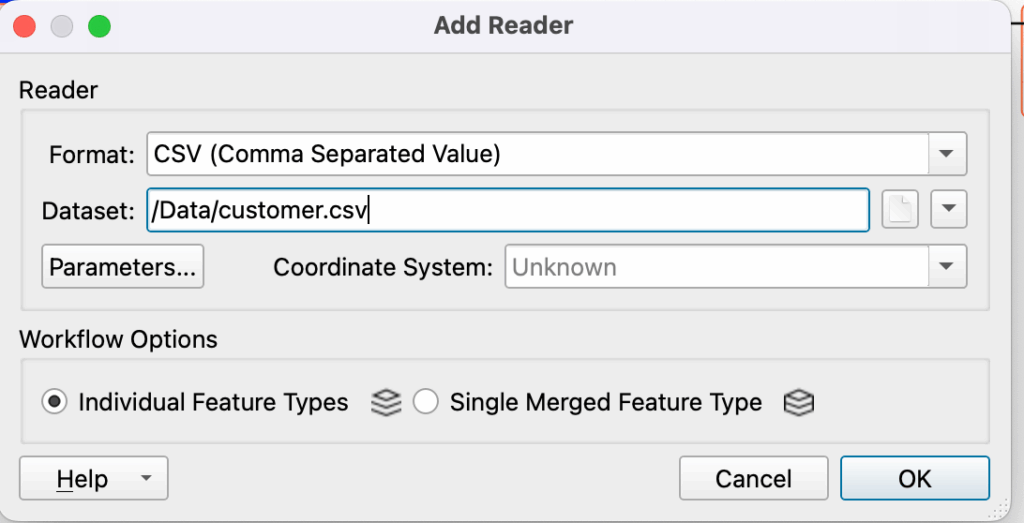
It’s necessary to configure the file type and then select the folder in which the data is present.
- Next, initialize the OpenAIChatGPTTransformer. You will use this transformer to identify the presence of credit card information in the text and replace it with the text MASKED_INFO.
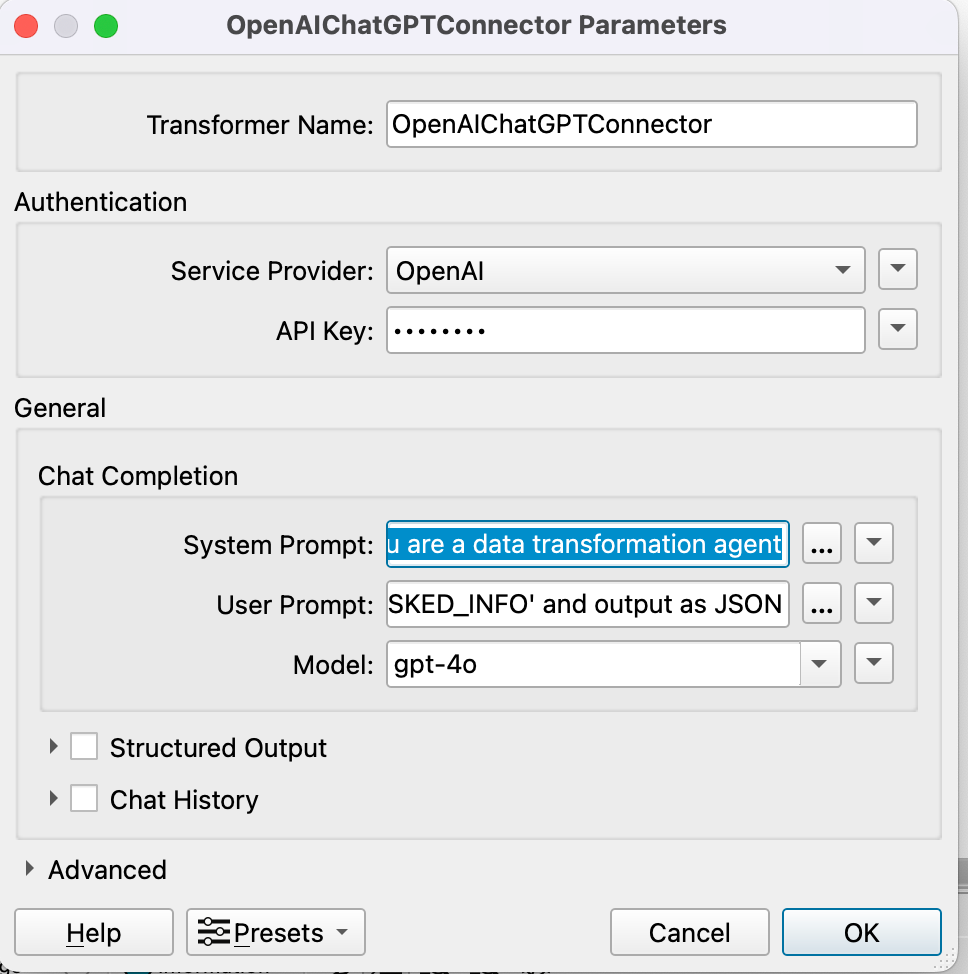
Note that we have configured the API key and two prompts here. The system prompt is configured as follows.
You are a data transformation agent
Here is the user prompt:
Identify if the provided content contains credit card information. If it is present, mask the content with ‘MASKED_INFO’ and output as CSV
The LLM will identify the credit card information based on its domain knowledge. If we were to do it in a non-agentic way, the developer has to understand the nuances of typical credit card number patterns and then write logic through code and regular expressions to replace them. That would require an expert engineering team and a data transformation platform. That said, the agentic method we use here would prove to be very expensive in this case, unless we have a locally hosted LLM.
- The next step is to create a writer that will write the transformed row as a CSV, as follows:
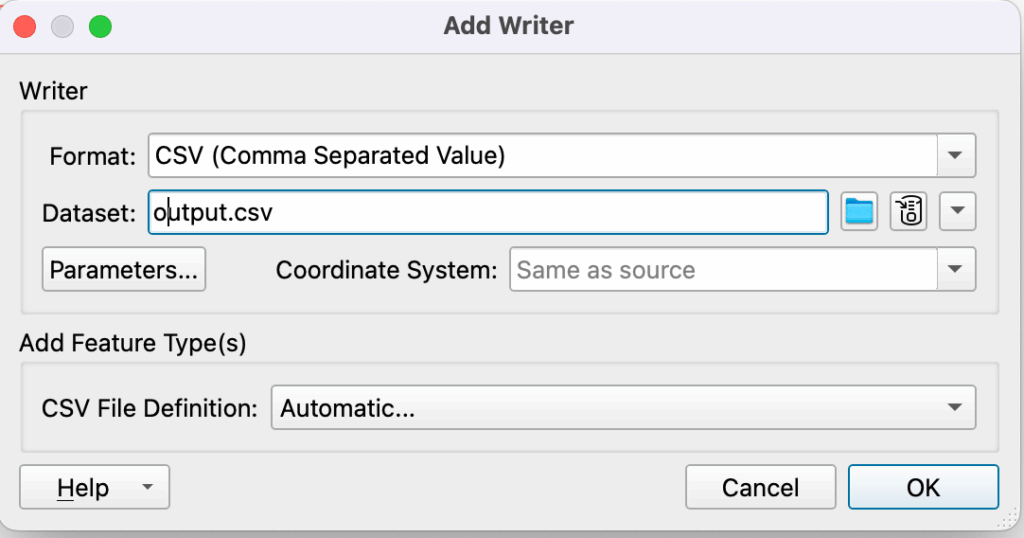
- Finally, stitch the four components together as a workflow, as shown below.
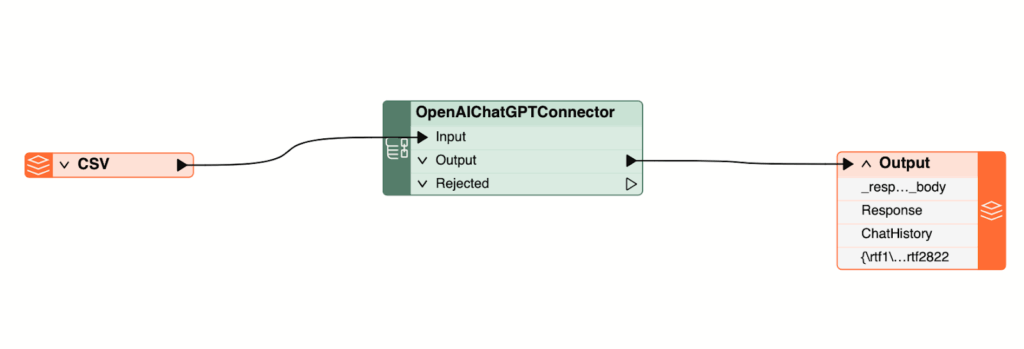
FME comes with several built-in transformers and can help any non-technical person to implement agent-based data transformation flows. It has comprehensive support for spatial computing data and helps even non-engineers work with geospatial data.
Creative agents
Creative agents can generate and optimize content like images, videos, code, etc., based on goals. Unlike simple prompt-based agents, they are intelligent enough to research reasons and come up with a plan to generate content. For example, given a prompt like “generate a marketing campaign image for a new tea brand,” they can first do market research, find out about the domain, and then come up with a plan. Tools like Synthesia are examples of this.
Like creative media, coding is another aspect where AI agents are quickly becoming popular. Agentic IDEs like Cursor IDE, Cody, etc, are capable of skimming through the complete code base and generating fixes. They can work based on goal-oriented prompts like “improve test coverage for the function generate_order_id” to help developers build solutions quickly.
Best practices
Even with no-code/low-code platforms and agent development frameworks, developing AI agents is not easy. Success depends on several factors, such as scaling, cost, and latency. The following section elaborates on some of the best practices to consider when implementing AI agents.
Start with an MVP and scale smart
Defining the exact use case and focusing on the core problem is very important when developing agents. The goal is to build a lean functional version of your agent to validate your hypothesis with a smaller group or a representative problem.
For an MVP, it is recommended to use a pretrained LLM and not to go for fine-tuning. Using a programmatic framework may not always be the best choice while building an MVP. Remember that the engineering aspects of an agent, like functions, tools, etc., are always solvable, and your focus during an MVP development must be on LLM-generated output, consistency, etc.
Consider prompt costs from the beginning
The biggest factor affecting cost in an AI agent is the prompt itself. You need to deeply analyze the size of the prompt and the amount of contextual information that is bundled with the prompt while implementing an AI agent. Remember to consider techniques like prompt compression and optimization options provided by LLMs like prompt caching.
Balance latency and multiple LLMs
One way to improve the accuracy and consistency of LLMs is to break down larger goals or tasks into smaller ones. However, while this improves accuracy, it also leads to multiple LLM calls and then increased latency.
Performance parameters like latency and cost play an important role in getting approvals and the acceptance of AI agents within organizations. It is important to consider these factors while envisioning AI agents. SLMs are a good option to manage the latency and cost, but this does require specialized training and initial development effort.
Choose the right framework
Building products is not only about getting their specifications right, but also about getting them ready for general usage at the right time. Your choice of agent development platform plays an important role in your time to production and the quality of the product. Programmatic frameworks like LangChain, Crew AI, etc, provide a flexible way of implementing agents, but they are often too complex for simpler use cases. This is where no-code/low-code frameworks like FME shine by striking a good balance between flexibility and ease of implementation.
The following aspects must be considered when choosing a framework for AI agent implementation:
- The framework must provide low-code approaches for most functions, like tool calling and function calling.
- It must have comprehensive support for data transformation by using drag-and-drop approaches and custom code plugins.
- The framework must have comprehensive support for all the popular LLMs, like OpenAI, Gemini, Claude, etc.
- Frameworks with built-in support for deployment orchestration and monitoring of agents go a long way toward streamlining organizational workflows.
If you are looking for an agent development framework with comprehensive low-code support while balancing the required flexibility, consider FME by Safe Software.
Implement a systematic testing method
When developing an AI agent, it is important to consider the testing methodology during the MVP phase itself. Define evaluation metrics and criteria and use the same criteria during the iterative phase once the MVP phase is completed. The testing must include verification of guardrails to ensure that an adversary cannot get the agent to make erroneous decisions or respond in a harmful way. A systematic test strategy ensures that the agent is usable by the time it is rolled out to production.
Last thoughts
AI agents represent a fundamental shift in the way organizations approach automation. They have evolved beyond traditional robotic process automation systems and have become collaborative assistants that can research, reason, and plan actions based on goals. They have revolutionized the customer service domain and can greatly improve employee efficiency through self-healing workflows and decision-making assistance.
Data agents can help in transformation workflows by handling schema drift, data mapping, security policy enforcement, and error correction. Creative agents help in generating content like images, videos, and code based on goals rather than elaborate prompts. Implementing AI agents to streamline organizational workflows and getting the most out of them is essential in the modern era. Agent development platforms like FME by Safe Software can help organizations to implement agents quickly without a steep learning curve.
Continue reading this series
AI Agent Architecture: Tutorial & Examples
Learn the key components and architectural concepts behind AI agents, including LLMs, memory, functions, and routing, as well as best practices for implementation.
AI Agentic Workflows: Tutorial & Best Practices
Learn about the key design patterns for building AI agents and agentic workflows, and the best practices for building them using code-based frameworks and no-code platforms.
AI Agent Routing: Tutorial & Examples
Learn about the crucial role of AI agent routing in designing a scalable, extensible, and cost-effective AI system using various design patterns and best practices.
AI Agent Development: Tutorial & Best Practices
Learn about the development and significance of AI agents, using large language models to steer autonomous systems towards specific goals.
AI Agent Platform: Tutorial & Must-Have Features
Learn how AI agents, powered by LLMs, can perform tasks independently and how to choose the right platform for your needs.
AI Agent Use Cases
Learn the basics of implementing AI agents with agentic frameworks and how they revolutionize industries through autonomous decision-making and intelligent systems.
AI Agent Tools: Tutorial & Example
Learn about the capabilities and best practices for implementing tool-calling AI agents, including a Python-based LangGraph example and leveraging FME by Safe for no-code solutions.
AI Agent Examples
Learn about the core architecture and functionality of AI agents, including their key components and real-world examples, to understand how they can complete tasks autonomously.
